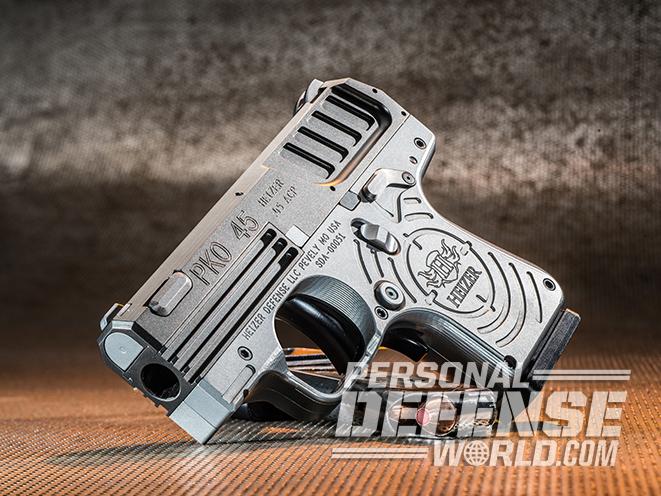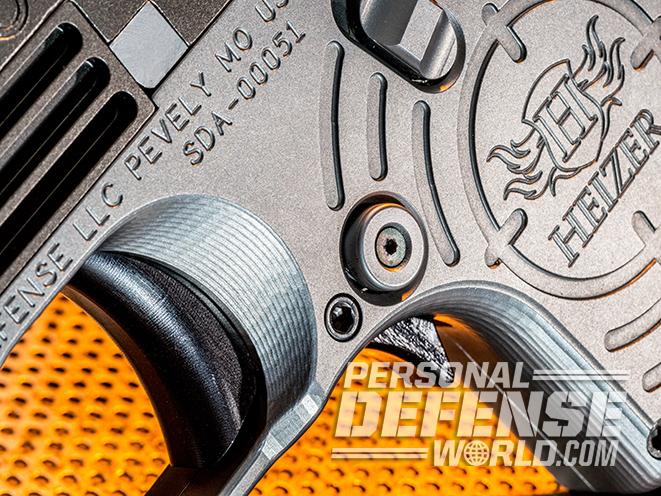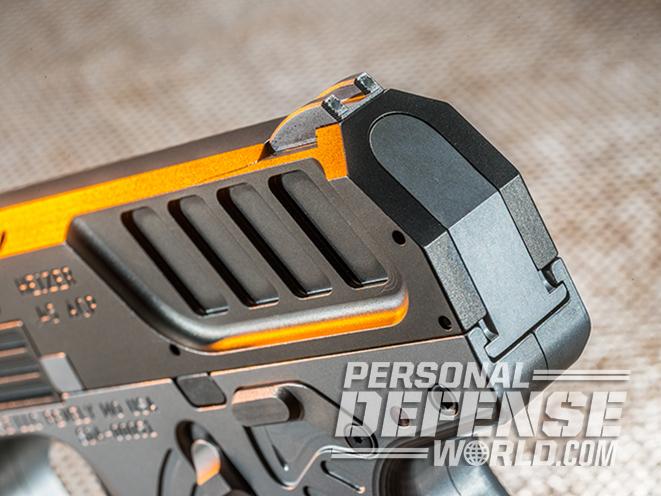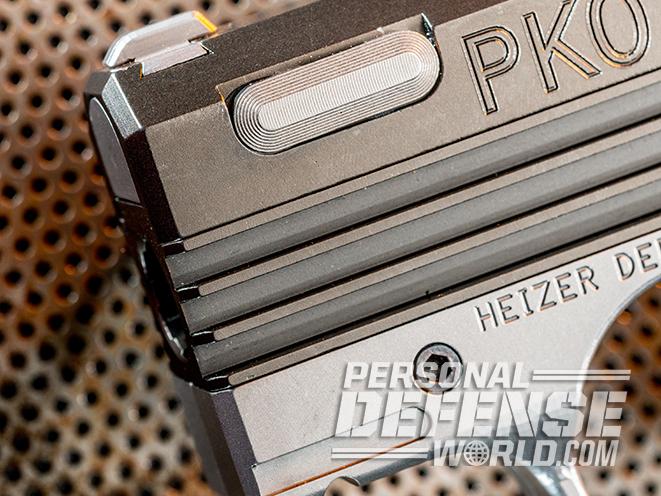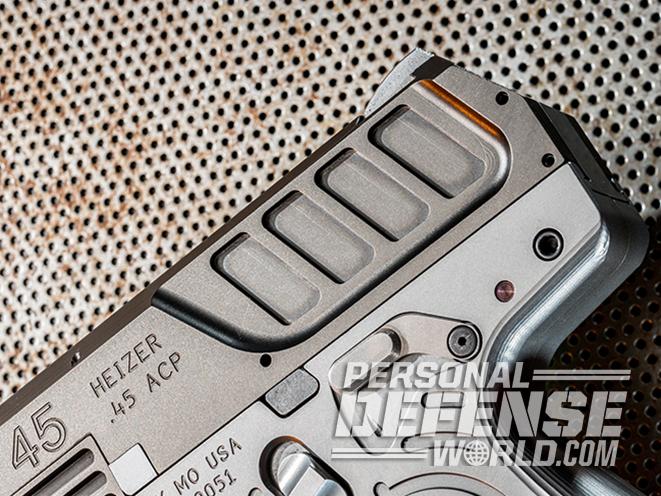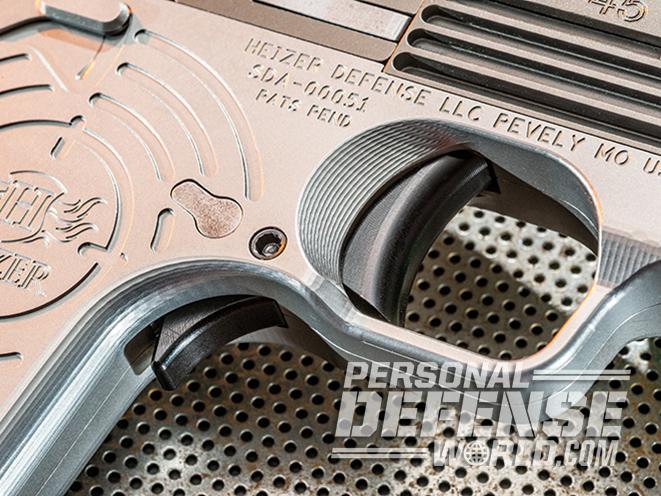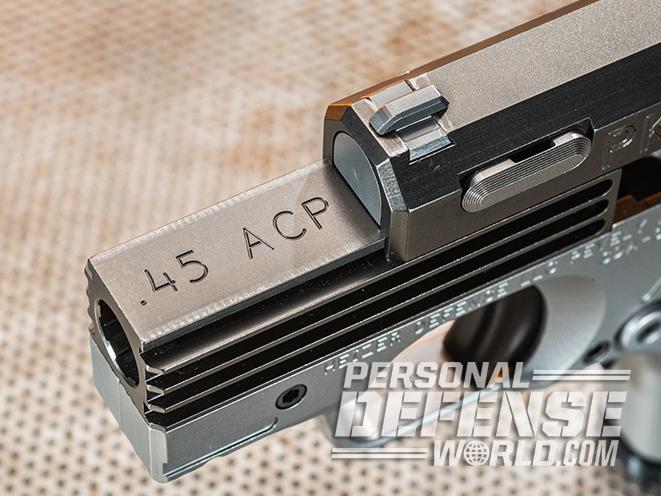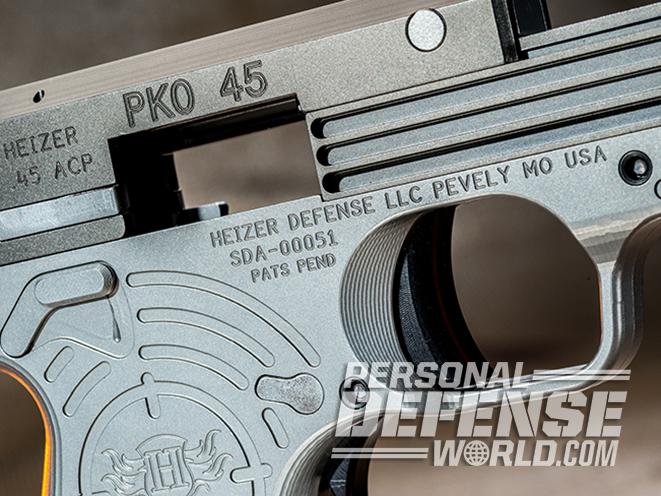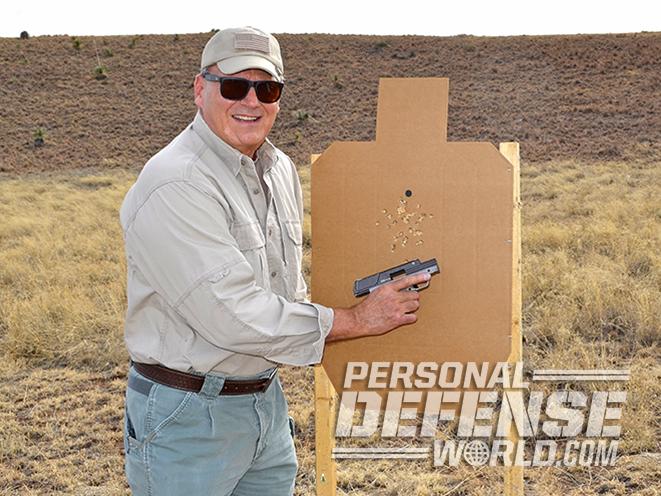It seems some of the world’s greatest inventions have started with a sketch on the back of a napkin. And so it was with the Heizer Defense PKO-45. According to Tom Heizer, he, his father and sister were sitting at a Houston restaurant table. They were there for the 2013 NRA Annual Meetings & Exhibits and had just introduced the PS1 pocket shotgun, a break-action, single-shot handgun chambered for .45 Colt cartridges and .410-gauge shotshells. As Tom put it, “Dad said, ‘Hey, I’ve got a good idea for a semi-auto pistol. It will have less moving parts and we can build it incredibly thin and still chamber it for a powerful cartridge.’”
As they looked over his shoulder, Charlie Heizer sketched what would become the PKO-45, a semi-auto chambered for the mighty .45 ACP, weighing just 25 ounces and measuring 0.8 inches thick. Blowback-operated, the PKO-45 uses a fixed barrel and a relatively light recoil spring. While the mechanical parameters of this gun might take a team of engineers with the latest computer programs and months of time to design, Charlie Heizer did it in just minutes with a ballpoint pen.
Heizer’s Ingenuity
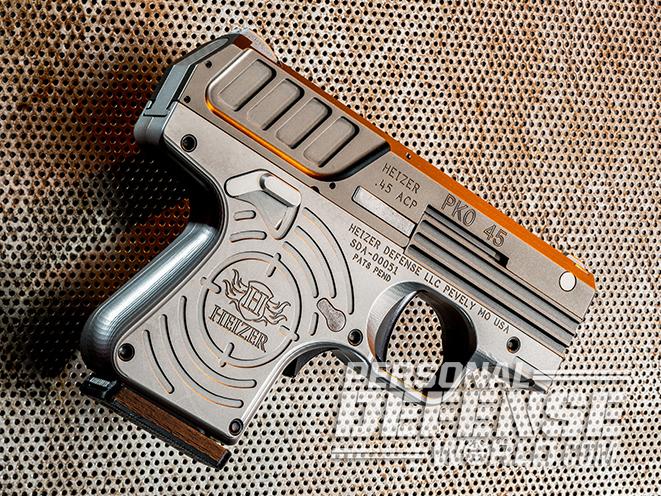
Advertisement — Continue Reading Below
Born in 1933, Charlie Heizer grew up in Hungary near the Austrian border and witnessed the horrors of war firsthand with his village being occupied first by German and then Russian troops. After the war, discarded military equipment became a treasure trove for the young man, who used his father’s machine and blacksmith shop to modify the parts. Farm equipment, motorcycles and firearms were some of Heizer’s favorite projects to build. At one point he found an old shotgun whose barrel had been damaged by the bombing. Heizer rebuilt the shotgun, cut down the barrel and handloaded his own shells using pieces of lead pipe for shot, and he was able to put rabbit and quail on his family’s dinner table.
An interest in all things mechanical led Heizer to get a bachelor’s degree in mechanical engineering and a master’s degree in internal combustion engines from the Budapest Institute of Technology. Just months away from receiving his doctorate degree, Heizer escaped the Hungarian Revolution in 1956 and landed in the United States with a toothbrush, a thermodynamics textbook and no working knowledge of the English language. Eventually he met and married another Hungarian refugee and started a family. Heizer established a small machine shop and landed a contract to make parts for Douglas Aircraft, and this led to other jobs with Boeing, Lockheed and Airbus as well as many of their suppliers. Fifty-five years after its inception, Heizer Aerospace now occupies over 300,000 square feet of manufacturing space.
But Heizer never abandoned his love of firearms and, using the excuse of diversifying, he established Heizer Defense to build guns. His extensive knowledge of steels, alloys and precision machining are as relevant to firearms as they are to aviation.
Advertisement — Continue Reading Below
I spoke to his son, Tom, recently, and he explained that every metal used in the PKO-45 is aerospace-grade stainless steel. “We machine everything in-house and even bore the gun’s barrel and rifle here at our factory in Pevely, Missouri.”
A Closer Look
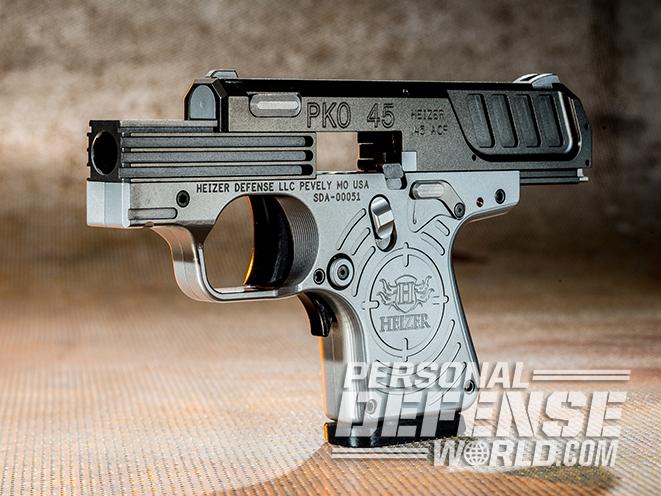
The PKO-45’s barrel is just 2.75 inches long, and its placement in the frame is the key to the gun’s controllability. The elder Heizer designed the gun with a fixed barrel and placed the recoil spring over the barrel. This translates to a lower bore axis in the shooter’s hand, minimizing muzzle flip.
Before I had a chance to handle the PKO-45, I was concerned that a blowback-operated gun chambered for the .45 ACP would have a horrifically strong recoil spring, but I was pleasantly surprised to find that this wasn’t the case. Despite the fact that the gun uses no sort of locking mechanism, it is easy to manually chamber a round. Heizer used a small-diameter, tightly wound recoil spring that possesses enough strength to retard the slide’s rearward velocity and chamber the next round in the magazine.
Advertisement — Continue Reading Below
The PKO-45 has a tube attached to the frame, just above the barrel’s chamber, and it extends almost all the way to the rear of the frame. The recoil spring slides inside the tube, which keeps it from kinking when the slide reciprocates. At the front of the slide, a takedown pin retains the recoil spring guide.
Heizer Defense machines the PKO-45’s frame from stainless steel in two halves and joins them, not by welding, but by using five screws. The halves are expertly fitted, and it’s hard to discern the seam. I asked Tom Heizer if the end-user should ever separate the two halves. “There’s really no reason to. We have done extensive testing and fired 5,000 rounds through one of our test guns. We separated the halves just to check for wear and found the gun’s internals to be very clean.”
- RELATED STORY: VIDEO – Wringing Out the Heizer Defense PKO 45
To keep the gun as trim as possible, Heizer designed the slide to run on rails inside the frame. An external extractor is also used on the PKO-45. Heizer places a small square of hardened steel on the slide at the point where the slide stop engages it to minimize wear. There’s a slide stop lever located between the manual thumb safety and the 1911-style magazine release. It is positioned appropriately for manipulation while maintaining a firing grip.
Advertisement — Continue Reading Below
At the front of the PKO-45’s frame is a grip safety. The pistol cannot fire unless this safety is depressed. In use, it is not noticeable and provides an additional safeguard to prevent an accidental discharge. The frame is undercut at the junction of the frontstrap and triggerguard, and this helps the shooter get a high grip on the gun. Additionally, the exaggerated heel of the frame helps the shooter lock the pistol into a secure firing grip.
An internal hammer is used on this gun—it’s not striker-fired—and the PKO-45 has an ambidextrous manual thumb safety. The pivoting safety will be familiar to 1911 users; up for “safe” and “down” for fire. In use, I often found myself visually checking to see if I had disengaged the safety, as the levers are very low profile. In my opinion, the levers should be slightly more pronounced for positive engagement.
Range Time With The PKO-45
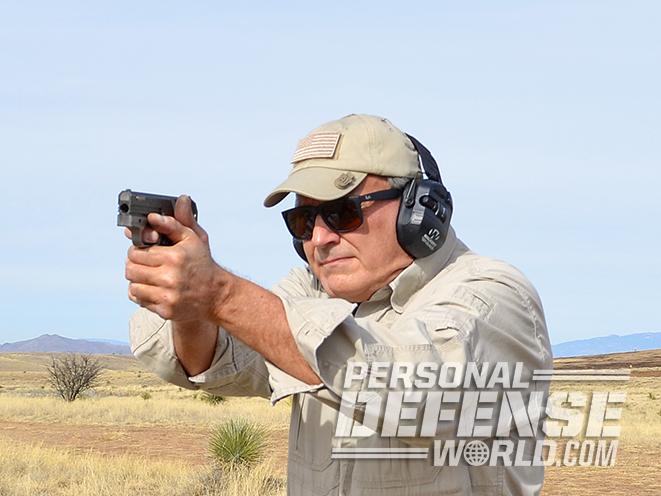
The trigger pull on my pre-production test sample was extremely crisp at about 6.5 pounds with a positive reset. Production guns will have sights manufactured by an outside contractor, but I had no problem aligning the low-profile sights. The accuracy was better than I would have hoped for with a gun possessing a 2.75-inch barrel, but it does have a decent sight radius of about 5.5 inches. I set up my targets at 10 yards and fired five-shot groups with each load, with the best groups listed here.
Advertisement — Continue Reading Below
Ruger’s new 118-grain ARX load printed the best five-shot group. This round continues to impress me and almost always turns in the best accuracy regardless of the caliber tested. It has very light recoil yet functions well in everything I have shot it in, and its point of impact is not noticeably different than the point of aim. It also possesses the second highest energy of the rounds I tested. CorBon’s 200-grain +P JHPs churned up an astonishing 392 foot-pounds of energy (fpe) and printed a 1.5-inch group at 10 yards.
I set up a standard USPSA target at 5 yards and fired 10 magazines, five rounds each, rapidly into the target. Using Colt’s 230-grain National Match FMJs, all of the rounds hit the center “A” box. At 15 yards, I was able to easily double-tap a steel target. The PKO-45 is very controllable and does not have the torque many of the alloy-framed, subcompact 1911s possess. The gun’s low bore axis and well-designed grip account for its shootability. The gun recoils straight back into the hand with little muzzle flip.
Disassembly of the gun is an easy matter and does not involve any tools. After removing the magazine and ensuring the chamber is empty, engage the thumb safety and place a finger over the recoil spring guide on the front of the slide. On the left side of the slide, near the muzzle, is what appears to be a lever but in reality is more of a pin. Turn this lever and remove it from the slide. Now allow the recoil spring guide, under tension, to exit the slide. Remove the guide and spring, and then pull the slide rearward and off the frame. That’s as far as you should ever need to disassemble the PKO-45 for routine maintenance and cleaning.
Advertisement — Continue Reading Below
More Innovation
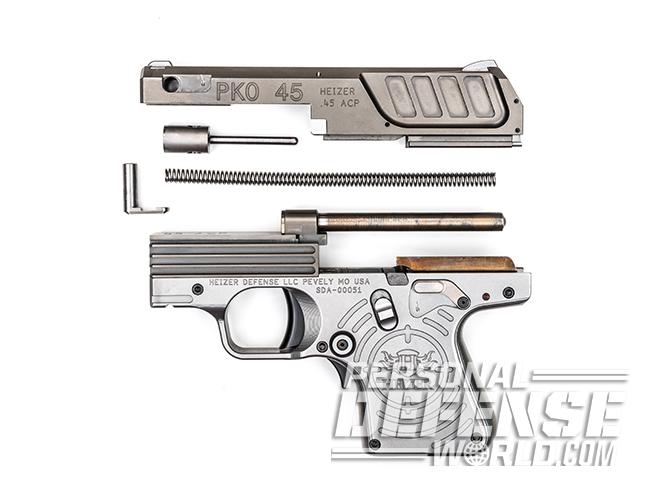
Heizer Defense will offer the PKO-45 in a variety of PVD-coated slide colors like Champagne, Copperhead, Ghost Grey and Technical Black, with the frame retaining its natural silver stainless steel color. The PVD coating is lubricious and eliminates the need for heavy lubrication on the slide rails.
Despite the fact the PKO-45 is just launching, Heizer Defense shows no signs of losing momentum. Already in the works is a PKO-45 with a titanium frame, which will shave about 4 ounces or a quarter-pound from the gun’s weight. Additionally, a version will be offered with an extended and threaded muzzle for suppressor use. The blowback operating system and fixed barrel will eliminate some problems normally associated with adapting a suppressor to a dropping-barrel semi-auto. Heizer Defense also plans to offer a semi-automatic 9mm pistol with an aluminum alloy frame in the near future.
Advertisement — Continue Reading Below
- RELATED STORY: 14 Excellent Everyday Carry Handguns to Back You Up
I fired over 300 rounds through the PKO-45 during the course of my evaluation. It is accurate, reliable and controllable, and its thin dimensions, rounded contours and light weight are certain to make it a top choice for concealed carry. A product of a mechanical genius with an inventive bent, the PKO-45 will appeal to those who recognize quality and innovation and demand the best.
For more information, visit heizerdefense.com or call 888-965-0972.
